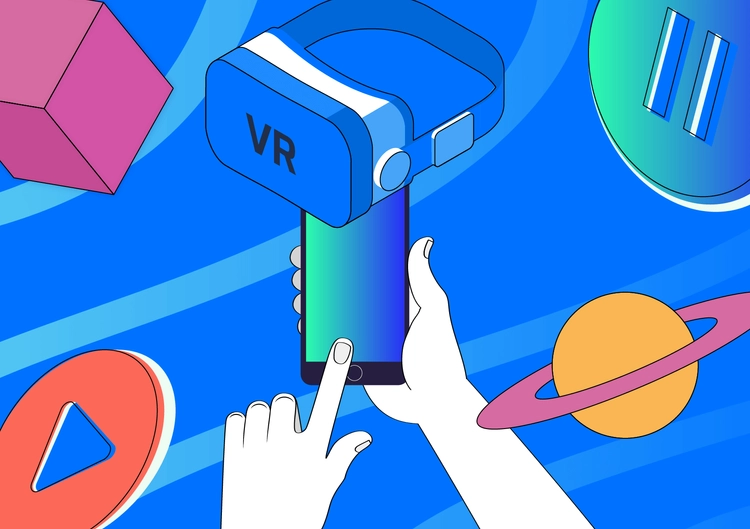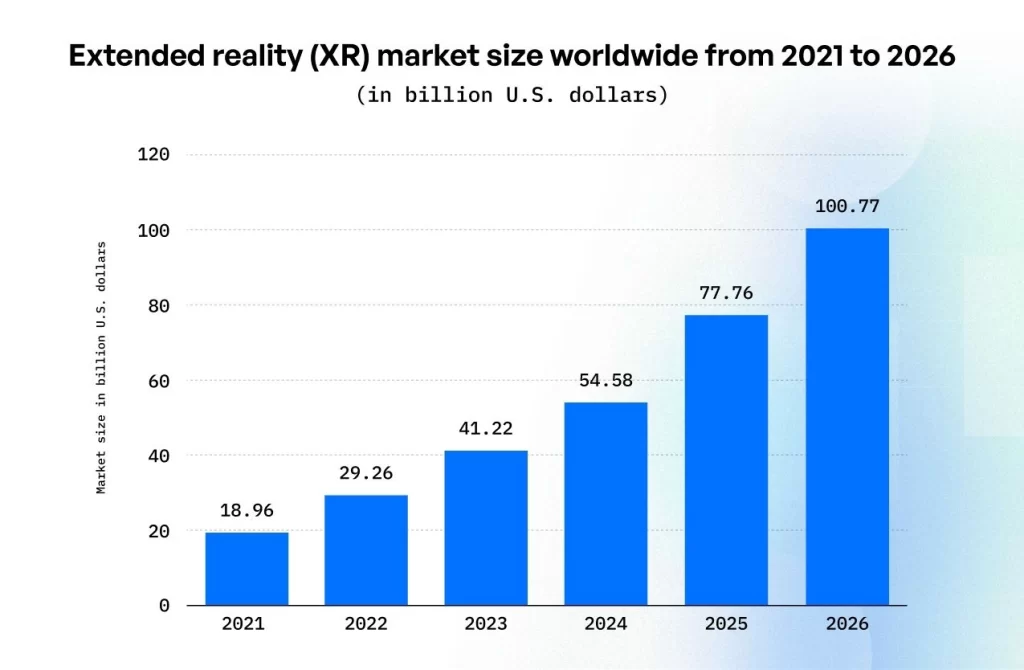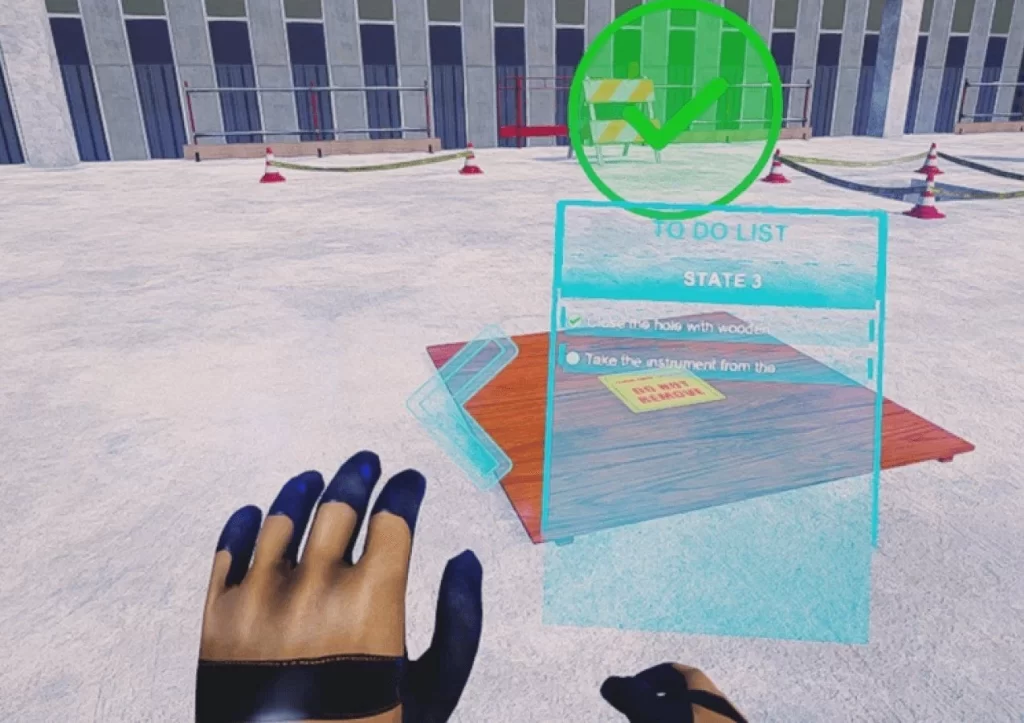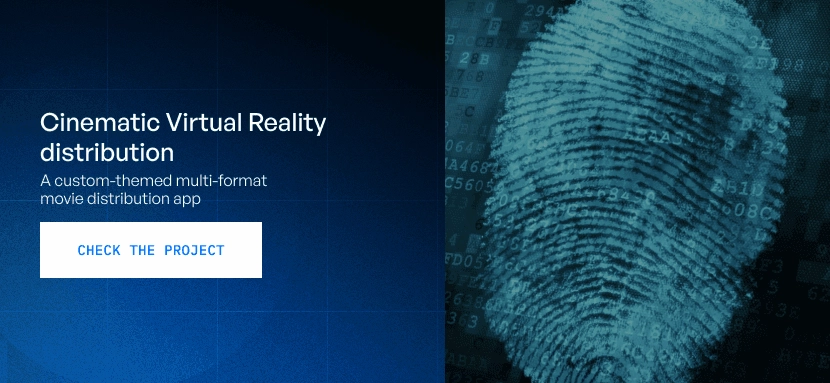A Deep Dive into Adapting Your App for Virtual Reality

As the demand for immersive and interactive content continues to rise, adapting the app to VR represents a strategic leap into the future of technology.
Whether you aim to enrich customer interactions, explore new revenue streams, or stay at the forefront of technological trends, embracing VR is pivotal.
This guide aims to navigate business leaders through the detailed steps involved in this transformational process. Leveraging our hands-on experience, the Alternative Spaces specialists share insights and practical steps on how to adapt the app to VR.
We unveil the VR potential and explore the possibilities of transforming your application into an immersive, interactive masterpiece.
Table of contents
- Why Integrate VR Into Your App?
- How to Adapt Your App to VR: Useful Tips
- Pitfalls of Adapting Your App to VR and Avoidance Strategies
- Our Experience
- Conclusion
- FAQ
Why Integrate VR Into Your App?
App integration with VR is not just a technological innovation but also a catalyst for redefining user interactions within applications. According to Statista, the global VR market will reach over 100 billion U.S. dollars by 2026.

Here, we delve into some compelling reasons why adapting the application to virtual reality may be beneficial.
Enhanced user engagement
VR technology creates a sense of presence in a virtual environment, allowing users to interact with content in a way that goes beyond traditional interfaces. This heightened level of engagement is achieved through realistic simulations, interactive elements, and a sense of being physically present, making the user experience more compelling and memorable.
Competitive edge in the market
VR offers innovative and unique features that set a product or service apart from competitors. VR enhances user experiences, providing a novel, immersive dimension that attracts and retains users. Adopting cutting-edge technology differentiates a product and signals a commitment to staying at the forefront of industry trends. This competitive advantage can increase user acquisition, customer satisfaction, and brand recognition, positioning a business as an industry leader in embracing innovative technologies.
Extended user sessions
VR content’s interactive and engaging nature encourages users to spend more time exploring virtual environments or interacting with 3D elements. Compared to traditional interfaces, VR’s ability to create a sense of presence and involvement often leads to longer user sessions. This extended interaction time enhances user engagement and provides more opportunities for content consumption, interaction, and achieving the application’s goals.
New monetization opportunities
From premium VR content and in-app purchases of virtual goods to hosting paid virtual events and experiences, VR allows diverse and innovative ways to generate income. Subscription models can provide users access to immersive content, while branded collaborations and partnerships create opportunities for businesses to monetize through advertising and product placements within the virtual environment. This expansion of monetization avenues enhances an app’s financial prospects and positions it at the forefront of technological innovation, attracting users willing to invest in unique and engaging virtual experiences.
The benefits of adapting your app for VR are far-reaching, promising to meet modern users’ expectations and set the stage for continued success in the dynamic world of digital experiences.
How to Adapt Your App to VR: Useful Tips
Adapting your app to VR involves several vital steps to ensure a seamless and immersive experience for users. Here are some essential steps and practical tips on how to integrate VR into an app.
Define VR integration goals
Before adapting your app to VR, define clear integration goals. Understand the specific VR features and interactions you want to incorporate into your application. Whether creating an immersive storytelling experience, enhancing gaming elements, or introducing interactive simulations, having a well-defined goal sets the foundation for a successful VR adaptation. Consider user preferences and market trends to align your objectives with the expectations of your target audience.
Useful tip: Engage in user surveys and feedback sessions to gather insights into the VR experiences your audience desires. This proactive approach ensures that your integration efforts are user-centric and aligned with the expectations of your app’s community.
Check VR platform compatibility
Choosing the right VR platform is crucial for a successful adaptation. Research and assess the compatibility of your app with various VR platforms such as Meta Quest, Valve Index, or emerging technologies like Apple Vision. Each platform may have specific requirements and capabilities, so ensure that your chosen platform aligns with the goals of your app. Consider factors like hardware specifications, user base, and development support when making this critical decision.
Useful tip: Stay informed about the latest advancements in VR platforms. Regularly check for updates and new releases from major VR providers to leverage cutting-edge technologies and features that enhance your app’s VR experience.
Read also: How AR/VR Technologies Impact eLearning
Update the development environment
Ensure your development environment is VR-ready by upgrading tools and libraries and integrating VR software development kits (SDKs). VR SDKs provide essential resources and functionalities needed for seamless integration. Keep your development environment up-to-date with the latest VR-compatible engines, frameworks, and other dependencies. This ensures compatibility and facilitates a smoother development process.
Useful tip: Collaborate with your development team to establish a consistent workflow and version control system. This helps streamline integration and ensures everyone uses the latest VR-compatible tools.
Implement a VR user interface
Designing a VR-friendly UI is crucial for a successful adaptation. Consider the unique aspects of VR interactions, such as depth perception and spatial awareness. Create intuitive and immersive UI elements that enhance rather than distract from the overall experience. Follow the guidelines of the XR platforms, and experiment with placing menus, buttons, and information displays to optimize user comfort and engagement in the VR environment.
Useful tip: Prioritize simplicity in your VR UI design. Clear, concise, and easy-to-navigate interfaces contribute to a more enjoyable user experience in virtual reality.
Optimize 3D assets for VR performance
Optimizing 3D assets for VR performance involves reducing polygon counts, using efficient textures, implementing level-of-detail adjustments, optimizing material shaders, utilizing batching and instancing, applying occlusion culling, considering static and dynamic objects, optimizing for VR-specific rendering techniques, regularly testing on target VR hardware, and employing asset bundling and streaming. These steps balance visual quality and performance, ensuring a smooth and immersive virtual experience for users.
Useful tip: Leverage tools and techniques for automated asset optimization. This simplifies the process and ensures consistent performance across various VR platforms.
Implement VR input handling
Integrate VR input controls for navigation and interaction. Utilize motion controllers and gestures for a natural and immersive user experience. Regularly refine input mechanisms based on user testing and feedback.
Useful tip: Design intuitive controls that mimic real-world interactions to enhance user engagement.
Read also: VR Guide to Create Your VR Training Solution
Update camera systems
Modify camera systems to accommodate VR perspectives. Implement VR-specific camera controls for a comfortable and seamless view. Regularly test camera adjustments to ensure visual comfort for users.
Useful tip: Follow the camera settings and VR rendering provided by the SDK platform. Try not to move the virtual user unnaturally, quickly, or with high acceleration.
Test and iterate regularly
Regularly test your VR adaptation on target platforms and devices. Engage in continuous user testing to gather feedback on various aspects, including comfort, performance, and user interactions. Create feedback loops within the app to encourage users to share their experiences and suggestions.
Useful tip: Establish a routine for scheduled testing and iteration phases, ensuring your app remains optimized for evolving VR technologies and user expectations. Prioritize addressing user-reported issues promptly to enhance user satisfaction.
By following these steps, you can successfully adapt your app to VR, providing users with an immersive and engaging experience tailored to the capabilities of virtual reality technology.
Pitfalls of Adapting Your App to VR and Avoidance Strategies
In this section, we uncover potential pitfalls that can arise during the adaptation process and offer practical tips to avoid or overcome these obstacles.
User experience issues
Motion sickness remains a significant concern, as poorly optimized VR experiences can induce discomfort. Complex navigation systems may need to be clarified for users, and consistent performance, such as lag or glitches, can disrupt immersion. Striking a balance between immersive visuals and an understandable interface is crucial to prevent overwhelming users. Inadequate testing on various VR devices can lead to overlooked issues, and a lack of clear user guidance within the app may leave users feeling lost. Failing to account for hardware limitations and ignoring user feedback can result in unrealistic expectations and missed opportunities for improvement.
Avoidance strategy: Prioritize VR design principles, including intuitive controls, comfortable navigation, and a user-friendly interface. Test extensively with potential users to identify design elements that may cause discomfort or confusion. Iterate your design based on user feedback to achieve a natural and immersive VR experience.
Inadequate performance optimization
VR experiences demand high-performance rendering to maintain smooth interactions and prevent motion sickness. Failing to optimize graphics, frame rates, and latency can lead to a subpar user experience, causing discomfort and disengagement. You must carefully optimize your apps for the specific hardware requirements of VR platforms, ensuring that the immersive environment runs seamlessly without graphical glitches or performance inconsistencies.
Avoidance strategy: Regularly test app performance. Optimize both code and 3D assets. Leverage tools for profiling and benchmarking to identify and address performance bottlenecks. Implement dynamic level-of-detail adjustments and balance visual quality and smooth performance. Regularly test on target VR hardware to ensure consistent performance across devices.
Read also: Implementing VR & AR in Medicine and Medical Training
Insufficient user onboarding
The complexity of VR environments requires clear and comprehensive guidance for users, but neglecting proper onboarding can result in confusion and frustration. Without practical tutorials or instructions, users may struggle to navigate the VR space and engage with the app’s features, leading to a poor user experience.
Avoidance strategy: Develop a comprehensive onboarding experience that guides users through VR controls, mechanics, and interactions. Implement interactive tutorials within the VR environment to familiarize users with the app’s features gradually. Regularly refine onboarding based on user testing and feedback to enhance user understanding and retention.
Our Experience
Alternative Spaces is a distinguished VR development company with extensive expertise in transforming ordinary concepts into cutting-edge interactive products that deliver immersive customer experiences. Leveraging the full spectrum of Virtual Reality capabilities, we specialize in crafting tailored solutions aligned with your business needs and goals.
We have delivered premium VR and AR development services to clients worldwide. Our experienced team has successfully executed projects spanning various industries, including gaming, entertainment, safety training, healthcare, interior design, culture, and beyond.
For example, we recently built a next-generation VR simulation for a skyscraper construction site, providing risk-free training, enhancing skills, reducing errors, and cutting costs.

Since the main goal was to simulate complex and dangerous working conditions, we prioritized creating graphics, highly detailed 3D models, and real-life VR training scenarios with a helpful hint system. We built an app to teach construction workers how to appropriately prepare for work shifts, correctly use harnesses, and follow the sequence of actions when working at height.
Additionally, we excel in building VR solutions for collaborative environments, exemplified by our coworking system that facilitates virtual meetings, conferences, and idea sharing.
We’ve ensured realistic, rich, detailed graphics to deliver the effect of presence and a fully immersive experience. Moreover, users can book or even buy a location where they want to hold conferences. Using VR technology, we made it easy for users to collaborate with their colleagues as avatars and share their ideas as quickly and simply as possible in realistic, immersive environments.
Alternative Spaces’s VR developers are affordable and available for projects of any type, scope, budget, and timeline. Through our staff augmentation services, you can scale your product development team or establish a new one, ultimately enhancing productivity and efficiency while reducing operating costs.
For businesses seeking to harness the power of VR, Alternative Spaces’s seasoned specialists are ready to bring innovative ideas to life!
Conclusion
Adapting the application to Virtual Reality is a dynamic process that demands careful consideration, creativity, and a commitment to delivering an exceptional user experience.
By embracing VR, you unlock the potential to captivate and immerse your users in ways previously unexplored. As technology evolves, integrating VR is not merely an enhancement but a strategic move to redefine engagement and stay at the forefront of innovation. Seize the opportunity, integrate VR into an app, and provide an immersive and unforgettable user experience!
FAQ
- What factors should be considered when adapting a regular app for VR?
When adapting a regular app for VR, critical factors include:
– a comprehensive redesign of the user interface to suit virtual reality environments
– rigorous performance optimization to ensure smooth interactions and prevent motion sickness
– implementation of VR-specific interaction methods for enhanced engagement
– integration of spatial audio to create an immersive auditory experience
– adaptation or creation of content tailored for VR
– extensive testing across various VR devices to ensure compatibility
– consideration of comfort measures to minimize motion sickness
– clear user onboarding processes to guide navigation
– awareness of specific hardware capabilities and limitations.
Attention to these factors ensures a seamless and immersive transition for users entering the VR environment.
- What features should be considered when adapting a regular app for Apple VR?
When adapting a regular app for Apple VR, key considerations include optimizing the user interface for three-dimensional experiences, ensuring high-performance graphics, and incorporating interactive elements like gaze-based interactions or Apple’s specific input methods. Spatial audio integration enhances immersion, and compatibility with Apple’s Vision hardware is paramount. Redefined in-app navigation and controls should align with Apple’s XR platform, and content adaptation to suit VR’s spatial and interactive nature is essential.
- How can I measure the success of my VR-adapted app?
The success of a VR-adapted app can be measured through various metrics that reflect user engagement, satisfaction, and the overall impact of the VR experience. Key performance indicators include user retention rates, session durations, and app usage frequency, which collectively indicate the app’s appeal and stickiness.
User feedback and reviews, mainly those specific to the VR features, provide qualitative insights into user satisfaction and potential areas for improvement. Monitoring the app’s performance on VR platforms, considering factors like load times and smooth interactions, is crucial.
Additionally, tracking the conversion rates of any monetization strategies within the VR environment and assessing how well the adapted app aligns with its original objectives contribute to a comprehensive evaluation of its success in the VR space.
- How do I begin adapting my app to VR?
To adapt your app to VR, define clear objectives for incorporating VR elements. Understand your target audience and identify the specific features that could benefit from a VR experience. Familiarize yourself with the guidelines and requirements of the chosen VR platform, whether it’s Meta, Microsoft Mixed Reality, Apple Vision, or another.
Next, you need to redesign your app’s user interface to suit the immersive VR environment, optimize performance for smooth interactions, and explore VR-specific interactions. Then, test extensively on various VR devices to ensure compatibility and address any issues.
If you need assistance with the VR adaptation process, don’t hesitate to contact specialists at Alternative Spaces, who can provide expertise and guidance to enhance your app’s transition into virtual reality.
Content created by our partner, Onix-systems.
Source: https://onix-systems.com/blog/how-to-adapt-your-app-to-vr Home
Home

